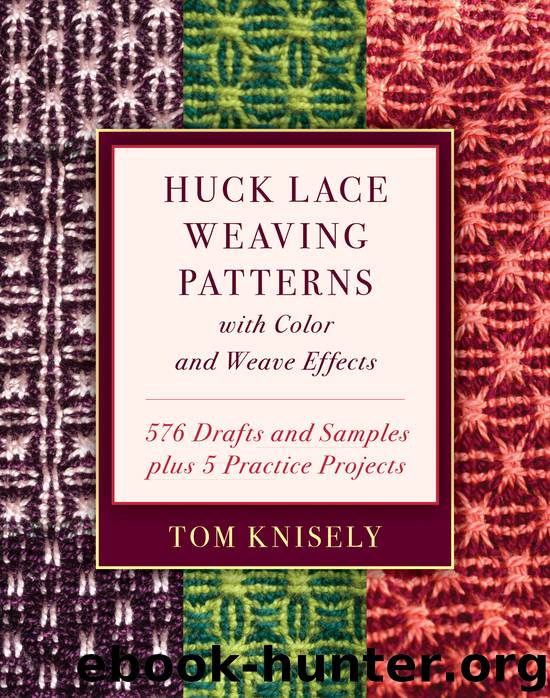Huck Lace Weaving Patterns with Color and Weave Effects by Tom Knisely

Author:Tom Knisely
Language: eng
Format: epub
ISBN: 9780811766876
Publisher: Stackpole Books
Published: 2019-06-16T16:00:00+00:00
How to Read the Drafts
Before you get started, it might be a good idea to understand how to read the drafts for this book. I have written the drafts and tie-ups for the rising shed (or jack) loom. It’s been my experience that weavers like this loom for the ease in the tie-ups and treadling. I’m a little old school and have woven Huck on a counterbalance loom, but it was sometimes challenging getting a clean shed. The raising of three shafts to make warp-way pattern floats was not always easy. The same when weaving weft lace and trying to depress three shafts on this sinking-shed loom. I have become spoiled with the ease of weaving on a jack loom. Yet I had to try weaving Huck on a counterbalance loom just to say that I did it and to experience it as did the weavers of years ago. Those old barn frame looms used counter-balance systems. It appears those weavers in the past faced many challenges when weaving Huck, and yet they wove yards and yards of linen fabric in Huck. The existing fabrics prove that point. If you weave on a countermarch loom, you will have no problems. (Counterbalance looms work by suspending the shafts from pulleys, rollers, or horses. Any draft that requires pairs of shafts alternating to create the pattern works well, but when you have a draft that has one shaft working against three, well, the shed is not often clear. This happens with many Huck patterns. A countermarch loom can be tied to cleanly lift one shaft against three or three against one.)
I have written the threading drafts to be read from right to left. I like using numerals to denote the shaft that is to be threaded. Because this is a pattern book of threading drafts that use color and weave effects, you will see that the colors of the squares denote the colors of the threads that are to be placed on those shafts. Pretty straightforward. If there is a curved line drawn below the squares of the threading draft, this is to show the sleying order. When the sett requires that more than one thread is sleyed in a dent, it is useful to show how best to sley the reed. Dark/light, dark/light, dark/dark, dark/light, dark/light. This sequence is then repeated across the warp.
Download
This site does not store any files on its server. We only index and link to content provided by other sites. Please contact the content providers to delete copyright contents if any and email us, we'll remove relevant links or contents immediately.
On Writing A Memoir of the Craft by Stephen King(4863)
The Doodle Revolution by Sunni Brown(4685)
A Simplified Life by Emily Ley(4098)
Mummy Knew by Lisa James(3630)
Marijuana Grower's Handbook by Ed Rosenthal(3619)
Better Homes and Gardens New Cookbook by Better Homes & Gardens(3524)
Figure Drawing for Artists by Steve Huston(3381)
Paper Parties by Erin Hung(3369)
Draw Your Day by Samantha Dion Baker(3287)
The Genius of Japanese Carpentry by Azby Brown(3224)
Japanese Design by Patricia J. Graham(3109)
The Code Book by Simon Singh(3074)
Dangerous Girls by Haas Abigail(2976)
Lions and Lace by Meagan Mckinney(2923)
The Curated Closet by Anuschka Rees(2912)
How to Make Your Own Soap by Sally Hornsey(2826)
The Checklist Manifesto by Atul Gawande(2776)
The Wardrobe Wakeup by Lois Joy Johnson(2732)
Zero to Make by David Lang(2726)
